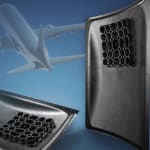 Manufacturing sandwich structures for airplane interiors cost effectively and quickly: With the polyethersulfone Ultrason E from BASF, manufacturers of interior airplane components can now take a great step forward in achieving this goal. The major advantage is that the same thermoplastic Ultrason can be processed into different components of the sandwich structure in a single tool. This reduces cycle times and thus also manufacturing costs. The sandwich consists of a foam core and carbon fiber laminates, which are all made of Ultrason E. If needed, the thermoformed foam core with cover layers can then be overmolded with the carbon-fiber reinforced Ultrason E 2010 C6 to incorporate reinforcements, structures or additional functional elements into the sandwich. The combination of 30% carbon fibers with the amorphous high-temperature plastic Ultrason guarantees extraordinary and constant mechanical properties for the light foam sandwich over a temperature range of -100 to +200°C.
Manufacturing sandwich structures for airplane interiors cost effectively and quickly: With the polyethersulfone Ultrason E from BASF, manufacturers of interior airplane components can now take a great step forward in achieving this goal. The major advantage is that the same thermoplastic Ultrason can be processed into different components of the sandwich structure in a single tool. This reduces cycle times and thus also manufacturing costs. The sandwich consists of a foam core and carbon fiber laminates, which are all made of Ultrason E. If needed, the thermoformed foam core with cover layers can then be overmolded with the carbon-fiber reinforced Ultrason E 2010 C6 to incorporate reinforcements, structures or additional functional elements into the sandwich. The combination of 30% carbon fibers with the amorphous high-temperature plastic Ultrason guarantees extraordinary and constant mechanical properties for the light foam sandwich over a temperature range of -100 to +200°C.Sandwich structures allow for particularly low weight while maintaining high flexural stiffness. Therefore this design is especially well suited for applications in the interior of airplanes, e.g. panels, side walls, luggage compartments, doors, cabin-separating walls, but also trolleys and cooking modules. Foams made of Ultrason E have been approved for use in airplanes. The material, with its exceptionally high limiting oxygen index of 38 (according to ASTM D 2863), distinguishes itself because it meets the requirements for commercial aircraft with regard to combustibility and heat release ("fire, smoke, toxicity") already without the addition of flame retardants, which means it is intrinsically flame retardant. This is why, for example, the Swedish aircraft supplier Diab uses the BASF polyethersulfone to manufacture foam core materials with different densities.
Sandwich components which can be manufactured thermoplastically in this way have numerous advantages compared to traditional honeycomb structures that are coated with phenolic resins: They can be produced faster in an automated process, they offer various processing options such as thermoforming into different geometries or overmolding for reinforcing ribs and additional functional integration. Thanks to weight-optimized, thermoplastic sandwich structures with additional functions it is possible to realize new lightweight materials for aviation, which have improved characteristics and a significantly reduced cost structure compared to traditional sandwich structures.



